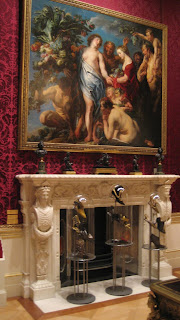Anthony Denney is not a name that I was familiar with before I visited this exhibition. Yet in the 1960s he was considered an icon of twentieth century style. Between 1964 and 1969 he lived at Rainham Hall, now a National Trust property and this year they are celebrating their fashionable resident in an exhibition about his life and work - click HERE for more information.
The textile art group, Material Girls have also created a display of their own contemporary work inspired by Denney - as a fashion photographer, interior designer, art connoisseur and a design icon.
Each section of the display relates to a different aspect of Denney's life. A famous photograph (which you can see on the Rainham Hall website) shows Denney inside a huge Chinese pot - and one of the Material Girls has recreated the pot in fabric (above) - apologies for not making a note of the artist's name.
The artists are also very generous in putting their sketchbooks on display (see above) so you can get an idea of just some of the work involved in getting their ideas from paper to thread.
This section (below) refers to his interest in interior design.
Another section (below) was devoted to Denney's interest in Japanese art and culture.
I was particularly intrigued by some of Beverley Folkard's miniature book art works (below).
Denney is not someone I knew of prior to this exhibition so a visit is not just a case of seeing some beautiful textile art, but also learning something new.
These images are just a very small selection of the work on display. The exhibition is free as most of it is in the Hayloft, the cafe next to the main building. There is a charge if you want to visit the house itself. Although I did not visit this time, it is an interesting place to visit. There will always be members of Material Girls on hand to talk to while their exhibition is open - which is until 16th February 2020. Check the Rainham Hall website for details of opening times etc or the Material Girls website for more information on their work.


















































